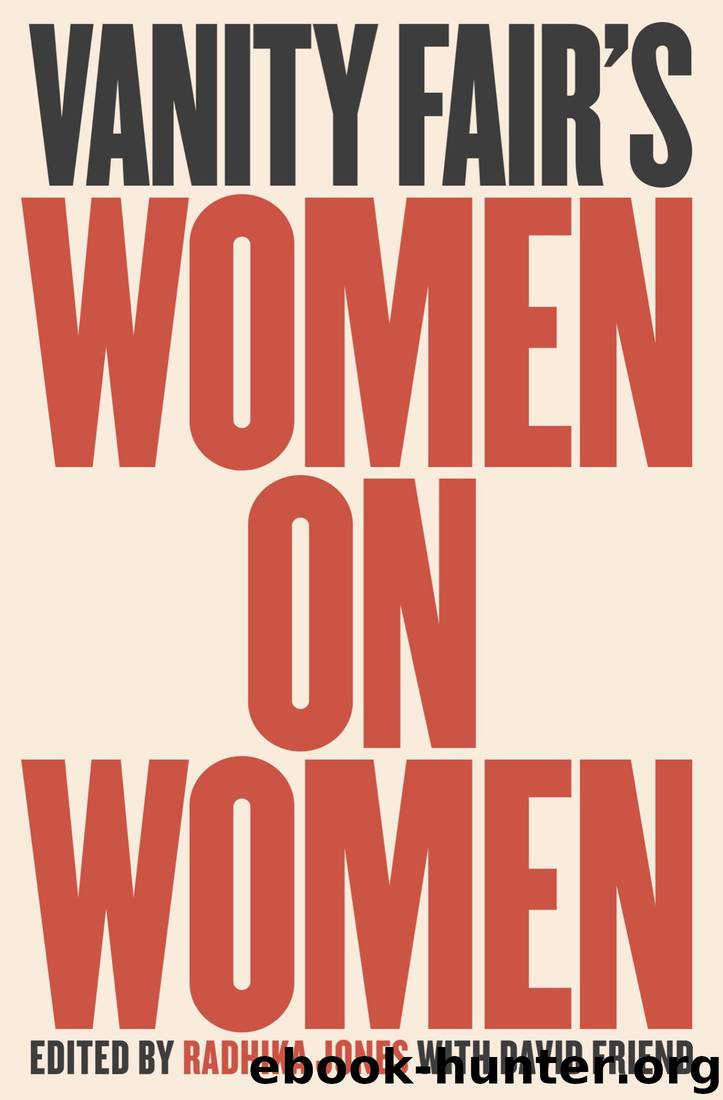Vanity Fair's Women on Women by Radhika Jones & David Friend & Radhika Jones

Author:Radhika Jones & David Friend & Radhika Jones
Language: eng
Format: epub
Publisher: Penguin Publishing Group
Published: 2019-10-29T00:00:00+00:00
* * *
—
John and Michelle bought 1930s actress-singer Jeanette McDonald’s grand Bel Air mansion. Lou was already living in that Old Guard hillock of estates, as was Beach Boy Brian Wilson, who’d painted his house purplish-pink. “John and Michelle kept peacocks,” Lou says, “who make a sound like women being raped,” and they would stroll the streets in their shimmery, sultan-worthy Profile du Monde caftans, intriguing the neighbors. They were always having big parties, for not only the Laurel Canyon rockers but also that hitherto separate species: movie stars. “Everyone came: Ryan O’Neal, Marlon Brando, Mia Farrow, Peter Sellers, even Zsa Zsa Gabor,” says Michelle. “One night I had to ask Warren Beatty to leave the house because he was screwing some girl in the nursery [that was being prepared for Chynna’s imminent birth].”
“I didn’t feel comfortable in that house; it was dark—and so was John’s vibe,” says Leah Kunkel. Tamar remembers “John not letting Michelle come out, once when I went to see her.” There was only one incident of domestic violence. “It was serious,” Michelle says. “I ended up in the hospital. That’s all I’ll say about it.”
Still, “spring and summer 1967, that was the moment,” Michelle recalls fondly. And a brief, shining moment it was, when everything that immediately thereafter would be sale-priced as a silly cliché was suddenly wildly glamorous: beautiful sybarites wafting around in clothes from other centuries; life as a sensual, acid-fueled private joke. At a meeting at the house with Lou, John and Michelle were asked by a music promoter to perform at a 12-hour music festival he was organizing. John and Lou, along with singer-songwriters Paul Simon and Johnny Rivers and producer Terry Melcher, bought the investor out, turned the festival into a charitable event, and expanded it to three days. They secured the Monterey Fairgrounds, which had jazz and folk festivals, as the venue in order to validate rock. Michelle manned the phones at the festival’s office on Sunset Boulevard every day, calling record executives, culling sponsors. There was a problem when the San Francisco groups at the heart of the new sensibility balked. “John and I represented what they didn’t like about the business. [We were] slick, we were successful,” and, says Lou, relatively Establishment. Only the persuasiveness of beloved Bay Area music columnist Ralph Gleason enabled the world to view the Jefferson Airplane, the Grateful Dead, and Big Brother and the Holding Company. (Janis Joplin was so much still the striving Texas naïf that she performed in a ribbed-knit pantsuit.)
The Monterey Pop Festival also premiered the electrifying sight of Seattle urchin turned 101st Airborne paratrooper turned British sensation Jimi Hendrix making love to his guitar and then immolating it. Laura Nyro, whose amazing soul operatics and zaftig, black-gowned appearance were decidedly non-psychedelic, knew that she had bombed and, worse, was sure she’d heard boos. She left the stage crying hysterically. (“Laura carried the baggage of that booing all her life,” Michelle says. In a tragic irony worthy of Maupassant, in the 1990s Lou and Michelle listened closely to the tapes of Laura’s performance.
Download
This site does not store any files on its server. We only index and link to content provided by other sites. Please contact the content providers to delete copyright contents if any and email us, we'll remove relevant links or contents immediately.
| Diaries & Journals | Essays |
| Letters | Speeches |
The Rules Do Not Apply by Ariel Levy(4866)
Bluets by Maggie Nelson(4478)
Too Much and Not the Mood by Durga Chew-Bose(4278)
Pre-Suasion: A Revolutionary Way to Influence and Persuade by Robert Cialdini(4153)
The Motorcycle Diaries by Ernesto Che Guevara(4018)
Walking by Henry David Thoreau(3897)
Schaum's Quick Guide to Writing Great Short Stories by Margaret Lucke(3322)
What If This Were Enough? by Heather Havrilesky(3275)
The Daily Stoic by Holiday Ryan & Hanselman Stephen(3238)
The Day I Stopped Drinking Milk by Sudha Murty(3160)
The Social Psychology of Inequality by Unknown(2941)
Why I Write by George Orwell(2880)
Letters From a Stoic by Seneca(2738)
A Short History of Nearly Everything by Bryson Bill(2631)
A Burst of Light by Audre Lorde(2548)
Insomniac City by Bill Hayes(2500)
Feel Free by Zadie Smith(2437)
Upstream by Mary Oliver(2347)
Miami by Joan Didion(2326)
